1995 CHEVROLET CORVETTE stop start
[x] Cancel search: stop startPage 51 of 386
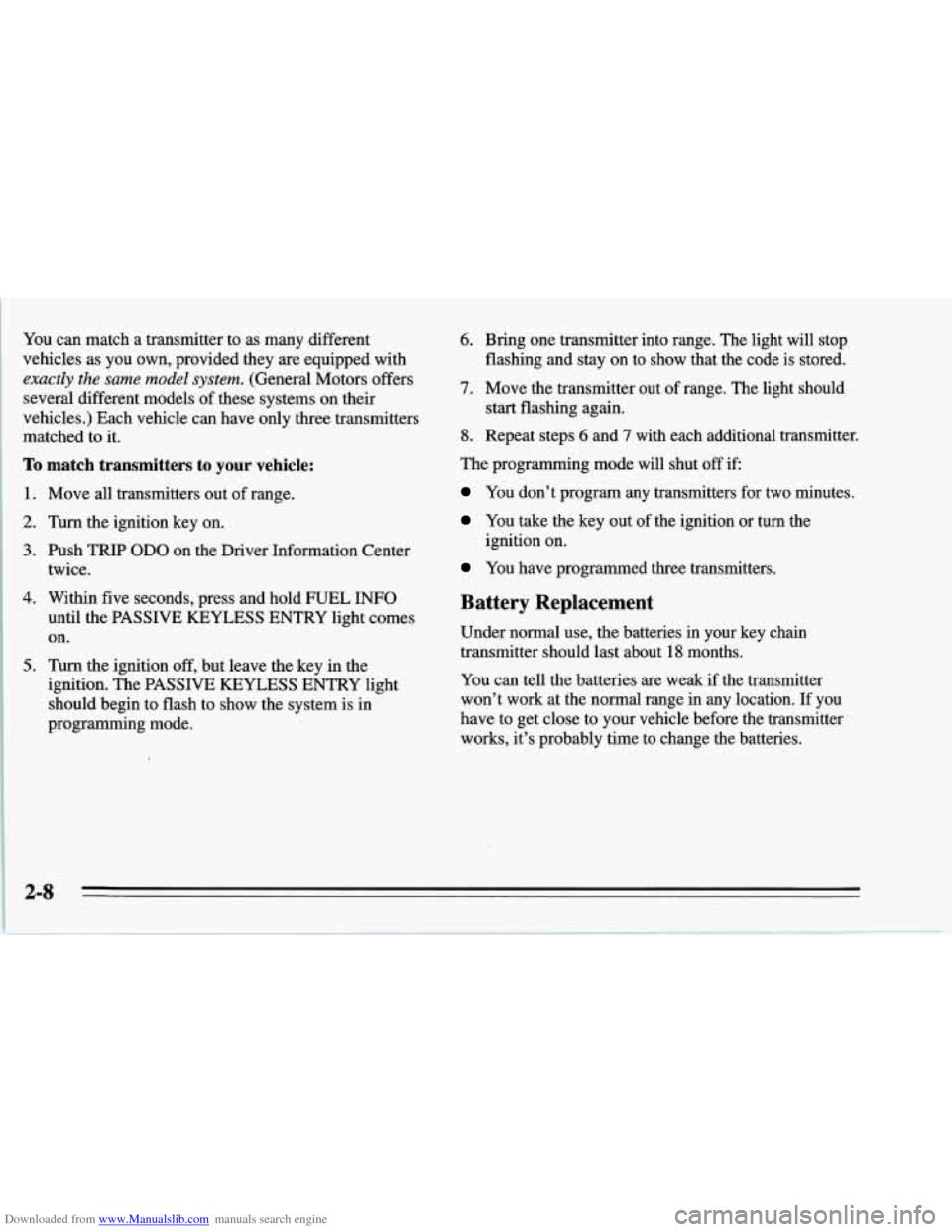
Downloaded from www.Manualslib.com manuals search engine You can match a transmitter to as many different
vehicles as you own, provided they
are equipped with
exactly the same model system. (General Motors offers
several different models
of these systems on their
vehicles.) Each vehicle can have only three transmitters
matched to it.
To match transmitters to your vehicle:
1. Move all transmitters out of range.
2. Turn the ignition key on.
3. hsh TRIP OD0 on the Driver Information Center
twice.
4. Within five seconds, press and hold FUEL INFO
until the PASSIVE KEYLESS ENTRY light comes
on.
5. Turn the ignition off, but leave the key in the
ignition. The PASSIVE KEYLESS ENTRY light
should begin to flash to show the system
is in
programming mode.
6. Bring one transmitter into range. The light will stop
flashing and stay on to show that the code is stored.
7. Move the transmitter out of range. The light should
8. Repeat steps 6 and 7 with each additional transmitter.
The programming mode will shut off if
You don’t program any transmitters for two minutes.
You take the key out of the ignition or turn the
start flashing again.
ignition on.
You have programmed three transmitters.
Battery Replacement
Under normal use, the batteries in your key chain
transmitter should last about
18 months.
You can tell the batteries are weak if the transmitter
won’t work at the normal range in any location. If you
have to get close to your vehicle before the transmitter
works, it’s probably time to change the batteries.
2-8
Page 56 of 386
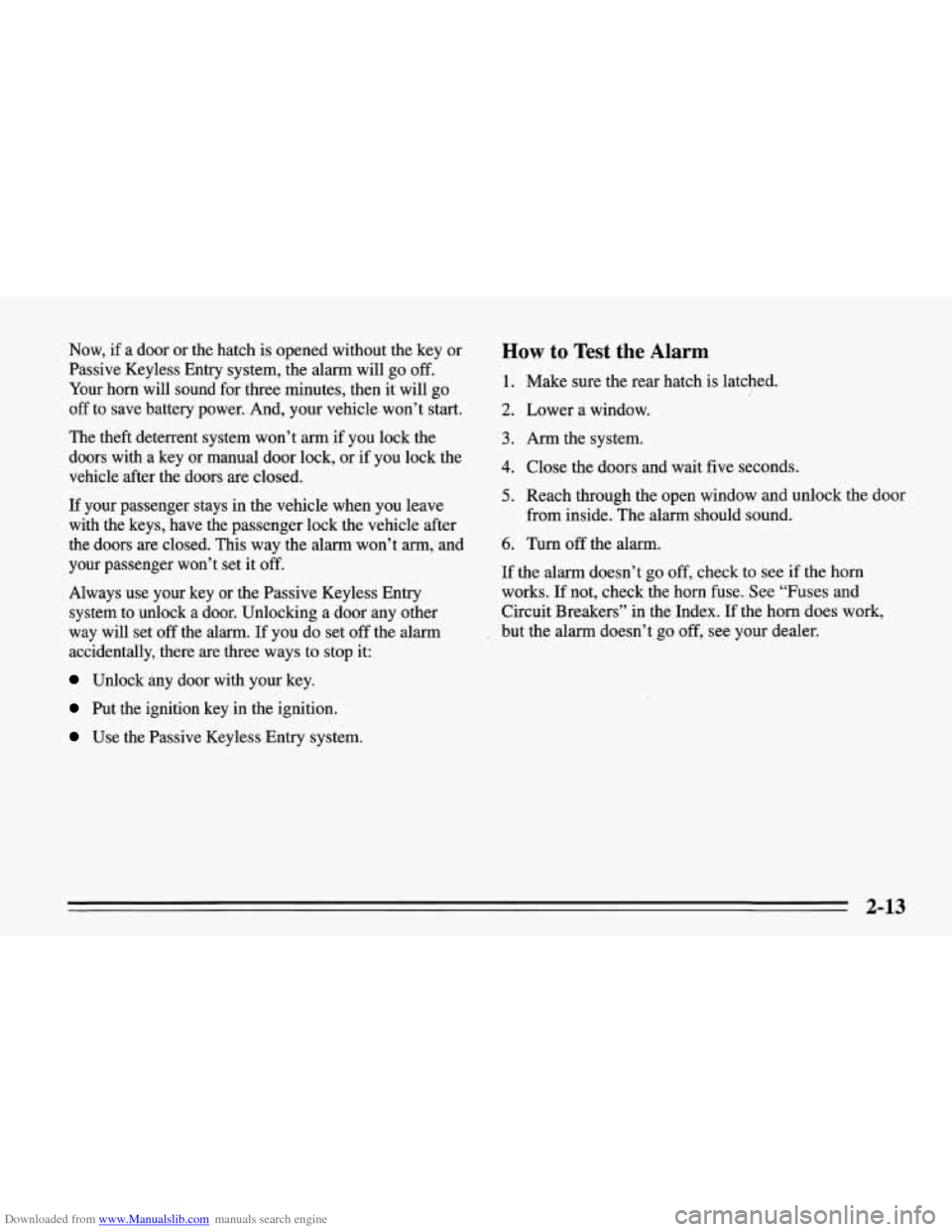
Downloaded from www.Manualslib.com manuals search engine Now, if a door or the hatch is opened without the key or
Passive Keyless Entry system, the alarm will go off.
Your horn will sound for three minutes, then it will go
off to save battery power. And, your vehicle won’t start.
The theft deterrent system won’t arm if you lock the
doors with a key or manual door lock, or if you lock the
vehicle after the doors are closed.
If your passenger stays in the vehicle when you leave
with the keys, have the passenger lock the vehicle after
the doors are closed. This way the alarm won’t
arm, and
your passenger won’t set it
off.
Always use your key or the Passive Keyless Entry
system to unlock a door. Unlocking a door any other
way will set off the alarm. If you do set off the alarm
accidentally, there are three ways to stop it:
Unlock any door with your key.
Put the ignition key in the ignition.
Use the Passive Keyless Entry system.
How to Test the Alarm
1. Make sure the rear hatch is latched.
2. Lower a window.
3. Arm the system.
4. Close the doors and wait five seconds.
5. Reach through the open window and unlock the door
from inside. The alarm should sound.
6. Turn off the alarm.
If the alarm doesn’t go off, check to see if the horn
works. If not, check the horn fuse. See “Fuses and
Circuit Breakers” in the Index. If the
horn does work,
. but the alarm doesn’t go off, see your dealer.
2-13
Page 58 of 386
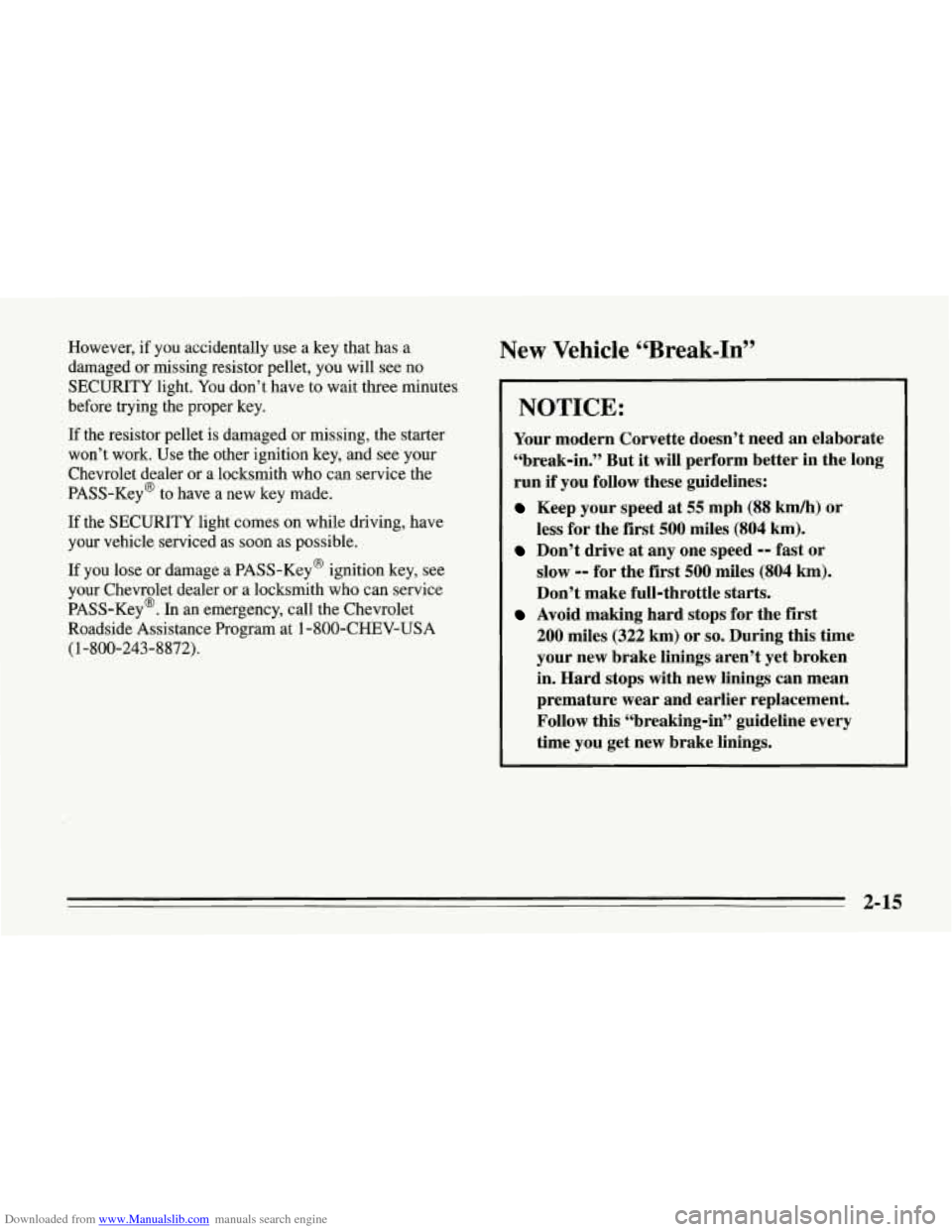
Downloaded from www.Manualslib.com manuals search engine However, if you accidentally use a key that has a
damaged or missing resistor pellet, you will see no
SECURITY light. You don’t have to wait three minutes
before trying the proper key.
If the resistor pellet is damaged or missing, the starter
won’t work. Use the other ignition key, and
see your
Chevrolet dealer or a locksmith who can service the
PASS-Key@ to have a new key made.
If the SECURITY light comes on while driving, have
your vehicle serviced as
soon as possible.
If you lose or damage a PASS-Key@ ignition key, see
your Chevrolet dealer or a locksmith who can service
PASS-Key? In an emergency, call the Chevrolet
Roadside Assistance Program at
1 -800-CHEV-USA
(1-800-243-8872).
New Vehicle “Break-In”
NOTICE:
Your modern Corvette doesn’t need an elaborate
“break-in.” But
it will perform better in the long
run if you follow these guidelines:
Keep your speed at 55 mph (88 km/h) or
less for the
first 500 miles (804 km).
Don’t drive at any one speed -- fast or
slow
-- for the first 500 miles (804 km).
Don’t make full-throttle starts.
200 miles (322 km) or so. During this time
your new brake linings aren’t yet broken
in. Hard stops with new linings can mean
premature wear and earlier replacement.
Follow this “breaking-in” guideline every
time you get new brake linings.
Avoid making hard stops for the first
2-15
Page 61 of 386
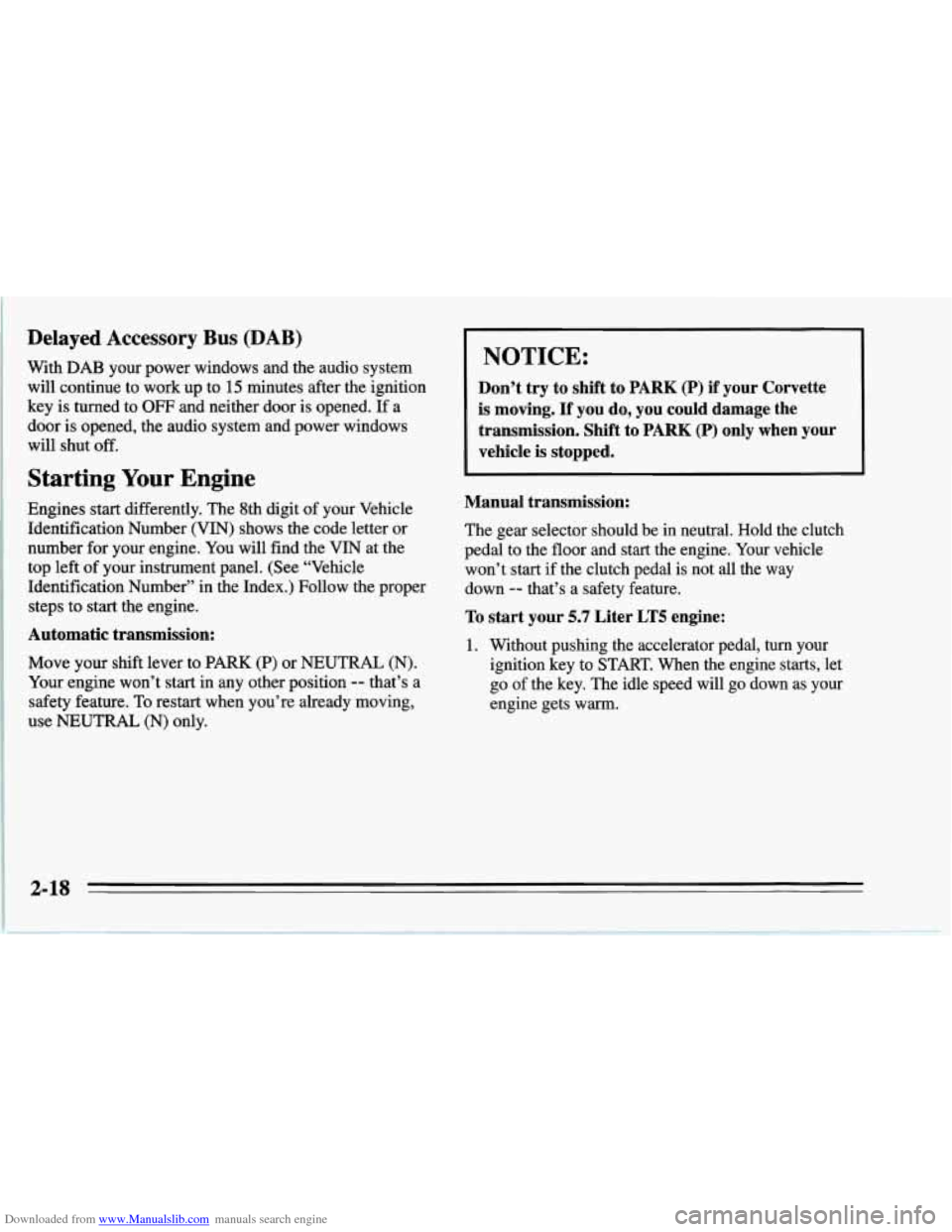
Downloaded from www.Manualslib.com manuals search engine Delayed Accessory Bus (DAB)
With DAB your power windows and the audio system
will continue to work up to 15 minutes after the ignition
key
is turned to OFF and neither door is opened. If a
door is opened, the audio system and power windows
will shut
off.
Starting Your Engine
Engines start differently. The 8th digit of your Vehicle
Identification Number
(VIN) shows the code letter or
number for your engine. You will find the
VIN at the
top left of your instrument panel. (See “Vehicle
Identification Number” in the Index.) Follow the proper
steps to
start the engine.
Automatic transmission:
Move your shift lever to PARK (P) or NEUTRAL (N).
Your engine won’t start in any other position
-- that’s a
safety feature. To restart when you’re already moving,
use
NEUTRAL (N) only.
NOTICE:
Don’t try to shift to PARK (P) if your Corvette
is moving.
If you do, you could damage the
transmission. Shift
to PARK (P) only when your
vehicle is stopped.
Manual transmission:
The gear selector should be in neutral. Hold the clutch
pedal to the floor and start the engine. Your vehicle
won’t start if the clutch pedal is not all the way
down
-- that’s a safety feature.
To start your 5.7 Liter LT5 engine:
1. Without pushing the accelerator pedal, turn your
ignition key to START. When the engine starts, let
go of the key. The idle speed will go down as your
engine gets warm.
Page 62 of 386

Downloaded from www.Manualslib.com manuals search engine NOTICE:
Holding your key in START for longer than
15 seconds at a time will cause your battery to be
drained much sooner. And the excessive heat can
damage your starter motor.
2. If it doesn’t start within 3 seconds, push the
accelerator pedal about one-third of the way down,
while you hold the ignition key in START. When the
engine starts, let go
of the key and let up on the
accelerator pedal. Wait about
15 seconds between
each try to help avoid draining your battery.
When starting your engine in very cold weather (below
0°F or -18”C), do this:
1. With your foot off the accelerator pedal, turn the
ignition key to START and hold it there. After two
seconds, push the accelerator pedal down just a little.
When the engine starts, let go
of the key. Use the
accelerator pedal to maintain engine speed,
if you
have to, until your engine has run for a while.
2. If your engine still won’t start (or starts but then
stops), it could be flooded with too much gasoline.
Try pushing your accelerator pedal all the way to the
floor and holding it there as you hold the key
in
START for about three seconds. If the vehicle starts
briefly but then stops again, do the same thing, but
this time keep the pedal down for five or six seconds.
This clears the extra gasoline from the engine.
NOTICE:
Your engine is designed to work with the
electronics in your vehicle.
If you add electrical
parts or accessories, you could change the
way
the fuel injection system operates. Before adding
electrical equipment, check with your dealer.
If
you don’t, your engine might not perform
properly.
If you ever have to have your vehicle towed, see
the part of this manual that tells how to do
it
without damaging your vehicle. See “Towing
Your Vehicle” in the Index.
2-19
Page 63 of 386

Downloaded from www.Manualslib.com manuals search engine To start your 5.7 Liter LTl engine:
1. Without pushing the accelerator pedal, turn the
ignition key to START. When the engine starts, let
go of the key. The idle speed will go down as your
engine gets warm.
I 1
I NOTICE:
Holding your key in START for longer than
15 seconds at a time will cause your battery to be
drained much sooner. And the excessive heat can
damage your starter motor.
2.
If it doesn’t start within 10 seconds, push the
accelerator pedal all the way to the floor, while you
hold the ignition key in START. When the engine
starts, let go of the key and let up on the accelerator
pedal. Wait about
15 seconds between each try to
help avoid draining your battery.
When starting your engine
in very cold weather (below
0°F or -18”C), do this:
1. With your foot off the accelerator pedal, turn the
ignition key to START and hold it there. When the
engine starts, let go of the key. Use the accelerator pedal
to maintain engine speed, if you have to, until
your engine has run for a while.
stops), it could be flooded with too much gasoline.
Try pushing your accelerator pedal all the
way to the
floor and holding it there as you hold the key in
START for about three seconds. If the vehicle starts
briefly but then stops again, do the same thing, but
this time keep the pedal down for five or six seconds.
This clears the extra gasoline from the engine.
2. If your engine still won’t start (or starts but then
I NOTICE:
Your engine is designed to work with the
electronics in your vehicle.
If you add electrical
parts
or accessories, you could change the way
the fuel injection system operates. Before adding
electrical equipment, check with your dealer.
If
you don’t, your engine might not perform
properly.
If you ever have to have your vehicle towed, see
the part of this manual that tells how to
do it
without damaging your vehicle. See “Towing
Your Vehicle” in the Index.
2-20
Page 68 of 386
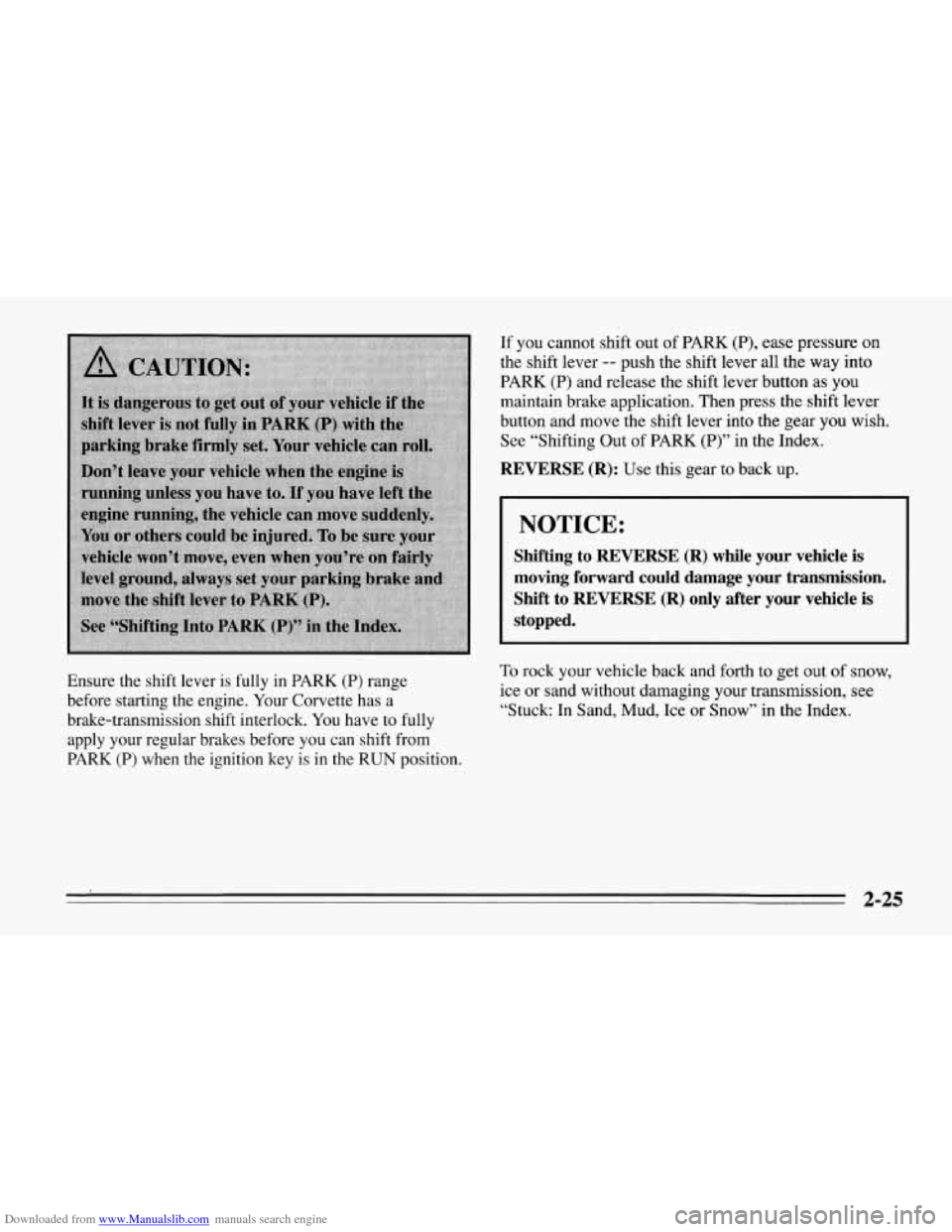
Downloaded from www.Manualslib.com manuals search engine If you cannot shift out of PARK (P), ease pressure on
the shift lever
-- push the shift lever all the way into
PARK (P) and release the shift lever button
as you
maintain brake application. Then press the shift lever
button and move the shift lever into the gear you wish.
See “Shifting Out of PARK
(P)” in the Index.
REVERSE (R): Use this gear to back up.
NOTICE:
Shifting to REVERSE (R) while your vehicle is
moving forward could damage your transmission.
Shift
to REVERSE (R) only after your vehicle is
stopped.
Ensure the shift lever is fully in PARK (P) range
before starting the engine. Your Corvette has a
brake-transmission shift interlock. You have to fully
apply your regular brakes before you can shift from
PARK (P) when the ignition key is in the RUN position. To rock your vehicle back and forth to get out of snow,
ice or sand without damaging your transmission, see
“Stuck: In Sand, Mud, Ice or Snow” in the Index.
2-25
Page 71 of 386

Downloaded from www.Manualslib.com manuals search engine Manual Transmission
Six-Speed
I This is your shift pattern.
Here’s how to operate your
transmission:
1
ttFl
2 4 6 .R
FIRST (1): Press the clutch pedal and shift into
FIRST (1). Then slowly let up on the clutch pedal as
you press the accelerator pedal.
You can shift into FIRST (1) when you’re going less
than
40 mph (64 km/h). If you’ve come to a complete
stop and it’s hard to shift into FIRST
(1), put the shift
lever in NEUTRAL (N) and let up on the clutch. Press
the clutch pedal back down. Then shift into FIRST
(1).
SECOND (2): Press the clutch pedal as you let up on
the accelerator pedal and shift into SECOND
(2). Then,
slowly let up on the clutch pedal as you press the
accelerator pedal.
THIRD, FOURTH, FIFTH AND SIXTH (3,4,5 and
6 ): Shift into THIRD (3), FOURTH (4), FIFTH (5) and
SIXTH
(6) the same way you do for SECOND (2).
Slowly let up on the clutch pedal as you press the
accelerator pedal.
TO STOP: Let up on the accelerator pedal and press
the brake pedal. Just before the vehicle stops, press the
clutch pedal and the brake pedal, and shift to
NEUTRAL
(N).
NEUTRAL (N): Use this position when you start or
idle your engine. Your shift lever is in NEUTRAL (N)
when it is centered in the shift pattern, not in any other
gear.
REVERSE (R): To back up, press down the clutch
pedal and shift into REVERSE (R). Just apply pressure
to get the lever past FIFTH
(5) and SIXTH (6) into
REVERSE
(R). Let up on the clutch pedal slowly while
pressing the accelerator pedal.
2-28